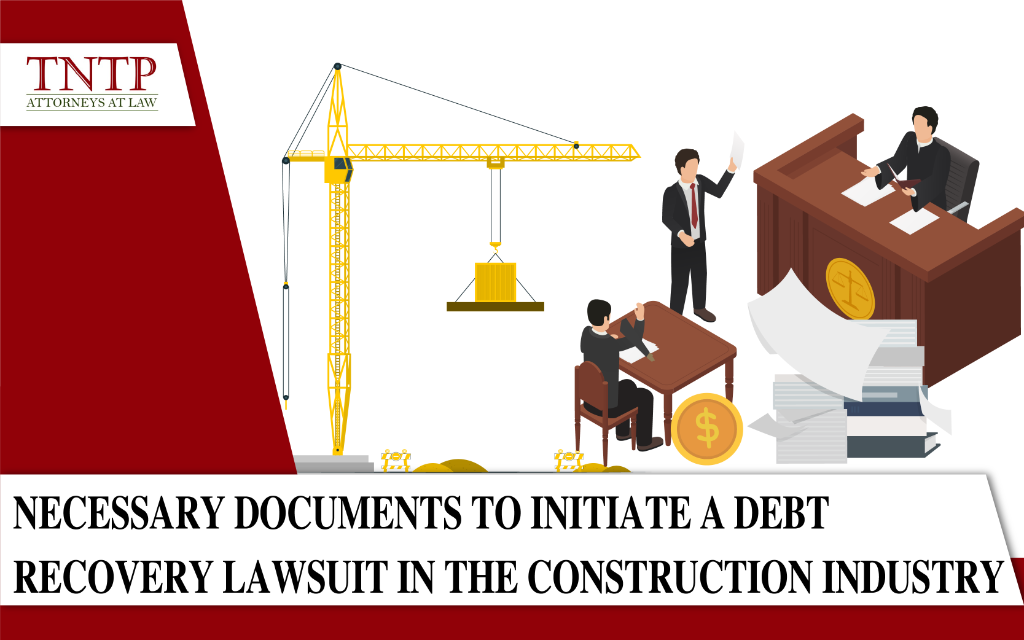Necessary documents to initiate a debt recovery lawsuit in the construction industry

Filing a lawsuit to recover debts is a common method of debt recovery in civil transactions in general and in the construction industry in particular. In such cases, the dispute resolution authority will review the lawsuit and the documentation and evidence provided by the business to determine whether to accept the filing. In this article, TNTP’s lawyers will provide their perspective on the necessary documents that businesses should prepare for initiating debt recovery lawsuits in the construction industry.
1. Purchase Contracts or Agreements and Service Agreements
Transactions in the construction industry among parties are considered civil transactions, and these transactions must be documented under various names such as contracts or agreements. These contracts or agreements specify the rights and interests of the respective parties based on legal provisions. When parties agree to enter into these civil contracts or agreements, they accept and are bound by the provisions therein. In the event of a dispute that cannot be resolved through negotiation, the parties have the right to file a lawsuit and request relevant authorities to resolve the dispute by law.
The content of the contract will bind the contracting parties, and if the debtor fails to fulfill their payment obligations according to the contract or agreement, the business has the right to demand payment, along with any compensation or penalties for breaches if such terms were included in the contract or agreement and are within the legal framework.
Furthermore, an important aspect of the contract or agreement is the designation of the competent dispute resolution authority. According to the provisions of the Commercial Arbitration Law and the Civil Procedure Code, if the parties have agreed in the contract or agreement to choose a commercial arbitration center as the dispute resolution authority, and such agreement is not restricted by legal provisions, the court will not have jurisdiction over the dispute. Conversely, if the parties have not reached an agreement on the choice of a commercial arbitration center as the dispute resolution authority, the arbitration center will also not have the jurisdiction to settle the dispute. Thus, the content agreed upon by the parties in the contract or agreement will determine the competent authority for dispute resolution.
2. Documentation to Verify the Execution of Contracts or Agreements
a) Delivery and Service Completion Records
These documents reflect the process of fulfilling obligations by the seller/service provider to the buyer/user of the service. The content of these documents may include the following: the name of the seller/service provider, the name of the buyer/user, tax identification numbers, the name/type of goods or services, the value of these goods or services, the date and time of delivery, and confirmations from both parties.
When carrying out the provisions of the contract or agreement, the delivery and service completion records serve as the basis for both parties to verify and reconcile the execution of related tasks. Simultaneously, they confirm the progress and value of the goods or services received. Collecting these documents in full will provide a clear foundation for dispute resolution authorities to address the case.
b) Purchase and Service Invoices
Similar to the delivery and service completion records, invoices are documents that confirm the sale and provision of services, which the seller and service provider declare to record information about the sale of goods and the supply of services in compliance with the law. Invoices are a crucial piece of evidence to be submitted to dispute resolution authorities because they are the clearest documents that prove the existence of the process of buying and supplying services in the case. Based on the content of these invoices, dispute resolution authorities will cross-reference payment amounts and the value of goods and services provided to determine whether the amount the business demands from the debtor is consistent with the invoices or not.
3. Debt Reconciliation Agreement
According to legal regulations, the parties are not obligated to enter into a Debt Reconciliation Agreement; however, this is an important and necessary document for dispute resolution authorities to accept a business’s lawsuit request.
A Debt Reconciliation Agreement is the parties’ confirmation of the amount that the debtor is obligated to pay based on the content of the previously agreed-upon contract or agreement up to the time the parties enter into the Debt Reconciliation Agreement. The amount stated in the Debt Reconciliation Agreement serves as clear evidence for the business to demand payment from the debtor. By entering into the Debt Reconciliation Agreement, the debtor acknowledges the debt, and they cannot deny their obligation to pay the debt. In such cases, dispute resolution authorities are likely to accept the business’s lawsuit request.
As this document is crucial to prove the debtor’s payment obligation, businesses should promptly prepare and request the debtor to verify and reconcile the debt based on accounting records and actual transactions, invoice figures, as well as any previous debts between the parties. This is done to determine the final outstanding debt that must be paid, preparing for the debt recovery phase if further disputes arise.
The above is an article by TNTP’s lawyers on the topic of ” Necessary documents to initiate a debt recovery lawsuit in the construction industry.” It is hoped that this article is helpful to readers.
Best Regard,



